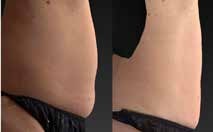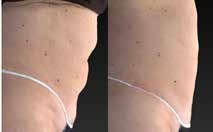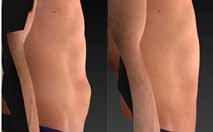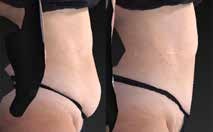TRANSFORMING BODY CONTOURS
Matteo Tretti Clementoni, Irene Fusco, Paolo Bonan and Valerio Pedrelli test microwave energy for abdominal fat reduction
While a healthy lifestyle consisting of regular exercise and proper nutrition remains essential when addressing localised abdominal subdermal adiposities, it does not always yield the desired results in achieving the perfect abdominal appearance. Consequently, there has been a growing demand for noninvasive treatments that can sculpt and redefine abdominal contours.
Traditionally, surgical procedures have been the go-to for achieving significant results. However, the current trend is shifting towards minimally or non-invasive techniques due to their reduced risks and shorter recovery times. One such emerging technology is the use of microwaves (MWs) for body sculpting. MWs have shown promise in improving abdominal aesthetics by reducing subcutaneous fat while simultaneously enhancing skin tightness. This article delves into a retrospective observational study aimed at evaluating the efficacy and safety of a novel MW-based device for abdominal fat reduction using advanced threedimensional (3D) imaging analysis.
METHODS
The study was conducted on twenty patients, comprising both males and females, who expressed dissatisfaction with their abdominal appearance. The average age of the participants was 48.7 years, with an average body mass index (BMI) of 27.2 kg/m2. They underwent treatment using the ONDA PLUS system (DEKA M.E.L.A, Florence, Italy), a state-of-the-art MW device designed for localised adiposity, cellulite, and skin laxity management.
The ONDA PLUS system utilises MWs with a frequency of 2.45 GHz, specifically designed to target subcutaneous fat. It employs a biophysical process called “dielectric heating” to deliver controlled and localised heat to the fat tissue, sparing the overlying skin layers. Moreover, the device incorporates a contact cooling system to protect the superficial skin layers from overheating.
Each patient received four treatment sessions, spaced four weeks apart, using the ONDA PLUS system’s deep handpiece to ensure optimal subdermal fat heating. The treatment duration for each abdominal area was approximately 15 minutes, with a starting power of 150 Wand a mean dose of 150,000 J per square area.
To assess the treatment’s efficacy, 3D imaging analysis was performed using the Vectra XT system at both baseline and three-month follow-up (3MFU) after the last treatment. This innovative technology allowed for precise measurement of abdominal volume and circumference changes.
In addition, a Numerical Rating Scale (NRS) was used to evaluate patient-reported pain during the sessions, and a satisfaction questionnaire was administered to gauge patient contentment with the treatment.
RESULTS
All twenty participants completed the full treatment cycle and attended the followup visits. The 3D imaging analysis revealed significant reductions in both abdominal circumference and volume at 3MFU compared to baseline measurements. Specifically, circumference decreased from 85.2 ± 8.1 cm to 80.8 ± 8.2 cm, and volume reduced from 1950.6 ± 471.0 cm3 to 1728.9 ± 490.9 cm3 (p < 0.001). These findings were indicative of successful subcutaneous fat reduction while preserving or enhancing skin tightness.
The NRS pain assessment indicated that the treatment was well-tolerated by the majority of patients, with a mean pain score of 0.5 ± 0.5 after the first session. Notably, no adverse effects were reported during or after the treatment sessions. Additionally, 90% of patients expressed their interest in undergoing the same treatment in other body areas, underscoring a high level of satisfaction.
DISCUSSION
Localised abdominal subdermal adiposities have long been a concern for individuals seeking improved body contours. Various treatments, ranging from surgery to non-invasive procedures, have emerged to address this issue. One of the promising non-invasive approaches is the use of MWs, particularly at a frequency of 2.45 GHz, to target subcutaneous fat while sparing the skin layers.
MWs exhibit deep subcutaneous adipose tissue penetration due to their dielectric properties, making them effective for fat heating. This technology promotes adipocyte heating without adversely affecting the overlying dermoepidermal layers. The study results support the hypothesis that MWs induce macrophage-mediated adipocyte lysis, leading to subcutaneous fat reduction and enhanced skin appearance.
Notably, MWs at 2.45 GHz behave differently than lower-frequency radiofrequency (RF) waves commonly used in body contouring. Skin is relatively transparent to MWs, allowing them to pass through the dermal-epidermal layers and focus their action on the subcutaneous fat.
This unique property makes MWs a valuable tool for body sculpting.
Additionally, MWs have shown the potential to improve skin texture and laxity by directly affecting collagen septa. This leads to collagen remodelling and the stimulation of fibroblasts, resulting in improved skin quality. Previous studies have also suggested MWs’ effectiveness in addressing cellulite, further expanding their utility in aesthetic treatments.
Figure 1 Average abdominal circumference in cm at baseline and 3MUF after the last session with the microwave system.
Figure 2 Average abdominal circumference in cm3 at baseline and 3MUF after the last session with the microwave system.

Figure 3

Figure 4

Figure 5

Figure 6
Representative case showing clinical improvement and morphological changes of abdominal appearance before and at 3MFU after the last treatment session.
CONCLUSION
The use of MW technology, combined with advanced 3D imaging analysis, seems to present asafe and effective approach to abdominal fat reduction and contouring. The ONDA PLUS system, with its 2.45 GHz MW frequency and contact cooling system, has demonstrated significant reductions in abdominal circumference and volume while ensuring patient comfort and satisfaction.
These findings highlight the potential of MW-based devices as a non-invasive alternative for individuals seeking to enhance their abdominal appearance. Further research and long-term follow-up studies are warranted to validate these results and explore the broader applications of MW technology in the field of aesthetic medicine. Nevertheless, the current evidence suggests that MWs have the potential to transform body contours and redefine the standard of care in abdominal fat reduction treatments.
REFERENCES
•Friedmann DP,Avram MM, Cohen SR, et al. An evaluation of the patient population for aesthetic treatments targeting abdominal subcutaneous adipose tissue.J Cosmet Dermatol. 2014;13:119-124.
•Mozaffarian D. Dietary and policy priorities for cardiovascular dis- ease, diabetes, and obesity:a comprehensive review. Circulation. 2016;133:187-225.
•Friedmann DP.Areview of the aesthetic treatment of abdominal subcutaneous adipose tissue: background, implications, and thera- peutic options. Dermatol Surg. 2015;41:18-34.
•KennedyJ, Verne S, Griffith R, Falto-Aizpurua L, Nouri K. Non- invasive subcutaneous fat reduction:areview.J Eur Acad Dermatol Venereol. 2015;29:1679-1688. •Saedi N, Kaminer M. Newwaves forfat reduction: highintensity focused ultrasound. Semin Cutan Med Surg. 2013;32:26-30.
•Jewell ML, Solish NJ, Desilets CS. Non-invasive body culpting technologies with an emphasis on high-intensity focused ultra- sound. Aesthetic Plast Surg. 2011;35:901-912.
•Bernstein D, Farberg AS, Khorasani H, Kriegel D. Noninvasive body contouring: literature review and summary of objective data. SKINJ Cutan Med. 2017;1:18-31.
•Bennardo L, Fusco I, Cuciti C, et al. Microwave therapy for cellulite: an effective non-invasive treatment.J Clin Med. 2022;11:515. •Bonan P, Verdelli A. Combined microwaves and fractional microab- lative CO2 lasertreatment for poSTPartum abdominal laxity.J Cosmet Dermatol. 2021;20:124-131.
•Nisticò SP, Bonan P, Coli F, et al.Anew protocol to treat abdominal subcutaneous fat combining microwaves and flat magnetic stimula- tion. Bioengineering. 2022;9:182.
•Franco W, Kothare A, Ronan SJ, Grekin RC, McCalmontTH. Hyperthermic injury to adipocyte cells by selective heating of sub- cutaneous fat withanovel radiofrequency device: feasibility stud- ies. Lasers Surg Med. 2010;42(5):361-370.
•Erends M, van derAaT, de Grzymala AP, van der Hulst R. Validity and reliability of three-dimensional imaging for measuring the vol- ume of the arm. Lymphat Res Biol. 2014;12(4):275-281.
• Killaars RC, Preu-MLG, de Vos NJP, et al. Clinical assessment of breast volume: can 3D imaging Be the gold standard? Plast Reconstr Surg Glob Open. 2020;8(11):e3236.
•Bernstein EF, BloomJD. Safety and efficacy of bilateral submental Cryolipolysis with quantified 3-dimensional imaging offat reduc- tion and skin tightening.JAMA Facial Plast Surg. 2017;19(5):350-357.
•Akita S,Tokumoto H,YamajiY, et al. Comparison ofVectra three- dimensional stereophotogrammetry measurement and tape mea- surement in the evaluation of perioperative volume change of the lower abdomen in association with lymphatic microsurgery. Microsurgery. 2022;42(1):50-56.
•TanakaY.Three-dimensional volumetric assessment of body sculpting usingauniform heating radio frequency device in Asians.J Cosmet LaserTher. 2015;17(4):194-199.
•Karcioglu O,Topacoglu H, Dikme O, Dikme O.Asystematic re- view of the pain scales in adults: which to use? AmJ Emerg Med. 2018;36(4):707-714. • Richard AJ,White U,Elks CM,et al., eds.AdiposeTissue: Physiology to Metabolic Dysfunction. South Dartmouth (MA): MDText.com, Inc.; 2000; 2020 PMID: 32255578 Bookshelf ID: NBK555602.
•Vale AL, Pereira AS, Morais A, et al. Effects of radiofrequency on adipose tissue:asystematic reviewwith meta-analysis.J Cosmet Dermatol. 2018;17(5):703-711. doi:10.1111/jocd.12776
•Boisnic S, Branchet MC, Birnstiel O, Beilin G. Clinical and his- topathological study of theTriPollar home-use device for body treatments. EurJ Dermatol. 2010;20(3):367-372. doi:10.1684/ ejd.2010.0938
•Valentim da Silva RM, Barichello PA, Medeiros ML, et al. Effect of capacitive radiofrequency on the fibrosis of patients with cellulite. Dermatol Res Pract. 2013;2013:715829. doi:10.1155/2013/715829
•You K. Introductory chapter: RF/microwave applications. In: You K, ed. Emerging MicrowaveTechnologies in Industrial, Agricultural, Medical and Food Processing. IntechOpen; 2018. doi:10.5772/ intechopen.73574
•Bonan P, Marini L, LottiT. Microwaves in body sculpting:a prospec- tive study. DermatolTher. 2019;32(2):e12782.
•Pahlavani N, Nattagh-Eshtivani E,Amanollahi A, et al. Effects of microwave technology on the subcutaneous abdominal fat and an- thropometric indices of overweight adults:a clinical trial.J Cosmet Dermatol. 2022;21(4):1482-1488. doi:10.1111/jocd.14245
•Foster KR, Ziskin MC, Balzano Q.Thermal response of human skin to microwave energy:acritical review. Health Phys. 2016;111:528-541. 26.Yang WJ, WangJH. Shortwave and microwave diathermy for deep-tissue heating. Med Biol Eng Comput. 1979;17(4):518-524.doi:10.1007/BF02447067
•Zerbinati N, d’Este E, Farina A, et al. Remodeling of collagen con- stituting interlobular septa of subcutaneous adipose tissue follow- ing microwaves application. DermatolTher. 2020;33(3):e13362. doi:10.1111/dth.13362